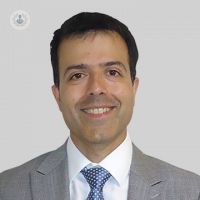What is nasal obstruction surgery for a blocked nose?
Autore:For a number of reasons, including a blocked nose, nasal obstruction surgery is sometimes performed to restore or improve airway flow in the nasal passages. Highly distinguished ENT surgeon Professor Paul Chatrath, provides an expert insight into this procedure.

When might nasal obstruction surgery be necessary?
Nasal obstruction can be caused by many different conditions, ranging from allergies to structural problems within the nose, such as a deviated nasal septum or nasal polyps, as well as infections due to sinusitis and problems occurring after trauma. Some of these conditions can be treated with sprays and medications, such as nasal sprays and antihistamines for allergic rhinitis, whilst others require surgery. A deviated nasal septum which is causing a blocked nose, for example, can only be treated by septoplasty surgery. A patient with nasal polyps who is not getting better after a trial of medications may need nasal polypectomy, while patients with recurrent sinusitis often benefit from endoscopic sinus surgery or the minimally invasive balloon sinuplasty procedure. Surgery becomes necessary where medications have failed to deliver an impact or where the structural deviation is so severe that surgery is the only option.
What are the benefits of nasal obstruction surgery?
The main benefit is that, if successful, the patient will be able to breathe better through the nose. This delivers advantages not only in feeling better during the day but, in some cases, also improving exercise tolerance and performance. Importantly, there are substantial benefits at night. As it improves the airflow through the nose, successful nasal surgery can lead to reduced mouth breathing, less snoring and a better-quality night’s sleep.
Can it be done in combination with cosmetic procedures?
Surgery to improve breathing through the nose can be combined with cosmetic rhinoplasty surgery. In fact, it is often very sensible to undertake both functional and cosmetic surgery at the same time, as this can often mean that a patient only needs one surgical procedure rather than two. This is beneficial from a safety perspective, not to mention being cost effective. It is also often the case, that some of the surgical techniques used to improve the nasal airway overlap with those undertaken to improve the aesthetic appearance of the nose. Therefore, combining the two objectives is also efficient from a surgical perspective, helping to minimise the number of surgical steps needed during the surgery and thereby reducing the risk of complications.
What happens during the procedure?
What happens can differ depending on the surgery being undertaken. Once the anaesthetic has been given, septoplasty or septorhinopalsty surgery can often be undertaken entirely by ‘keyhole’ - in other words, through the nostrils - without the need for any external incisions. Even if an external approach is needed, this usually only requires a small incision at the base of the nose, which usually heals very well. In cases where sinus surgery is being conducted, the operation is performed using high tech endoscopes which project the surgical view onto monitors. This magnifies the view and enables safe progress through all the surgical steps with minimal surgical trauma.
What can patients expect with the results from surgery?
In most cases, patients having nasal surgery notice substantial benefits in terms of an improved nasal airway. This may not be immediate due to the presence of swelling and inflammation immediately after the surgery, but once this has settled, breathing through the nose usually improves. Patients often find that they also sleep better at night, with less mouth breathing and less snoring. If cosmetic surgery is being conducted, there should be noticeable improvements in the external shape of the nose soon after the surgery. However, due to swelling and inflammation, it takes several weeks - if not months - for the majority of the swelling to subside, and up to a year or more for the final external cosmetic result to be achieved.
Professor Paul Chatrath is a highly distinguished ENT surgeon with practice in London, Brentwood and Buckhurst who specialises in rhinology and facial plastic surgery. If you’re considering nasal obstruction surgery, or simply wish to know more about the procedure, make sure to visit Professor Chatrath’s Top Doctors profile today.


